Mind your language
‘Not really,’ replied my husband when I asked if he thought it would be nice for us to have the Gibsons over for supper. If you knew the Gibsons (not their real name), you’d see the force of his answer.
Real is a slippery word. I laughed when reading, in Timothy Brittain-Catlin’s new book on parsonages, about mid-19th-century disapproval of stucco for making a building less real. Alfred Bartholomew (1801-1845), a translator of the Psalms and the architect of the Finsbury Savings Bank in Clerkenwell, prefaced his Specifications for Practical Architecture (1840) with a text in Hebrew, from the prophet Ezekiel: ‘One built up a wall, and, lo, others daubed it with untempered mortar. Say unto them which daub it with untempered mortar, that it shall fall.’ Victorian advocates of the Gothic saw truth in visibly structural forms, equating reality with virtue. The Architectural and Archaeological Society for the Country of Buckinghamshire heard at a meeting in 1849 that a parsonage should be ‘real, simple and religious’.
John Henry Newman was no champion of the Gothic, but he prized the real over the notional. ‘Religion has to do with the real, and the real is the particular,’ he wrote in The Grammar of Assent (1870). His biographer Ian Ker helpfully explains that Newman’s usage can be confusing here, because ‘the distinction is not in fact between sense perceptions and mental abstractions but between experiential and non-experiential knowledge’. So a mental act may be more vivid than a sensible object, and intimations of conscience can impress a real image of God upon us.
Newman had become preoccupied with the real much earlier in his life but, he had come to see, while working with the poor of St Clement’s in Oxford, that a standard evangelical distinction between ‘nominal’ and ‘real’ Christians did not work in practice.
In architecture, the real and realism got into a fearful tangle in the 20th century. The German Realismus, as Adrian Forty notes in his Words and Buildings, was applied to structural functionalism — as seen in the Eiffel Tower. The word Sachlichkeit was also wheeled out to imply ordinariness, lack of stylistic ornament, even homeliness.
Among those of Veronica’s age or younger, really has become an empty emphatic, usually reiterated, as in the Spice Girls’ classic utterance in Wannabe (1996): ‘I wanna really really really wanna zigazig ha.’










































































 Previous page
Previous page